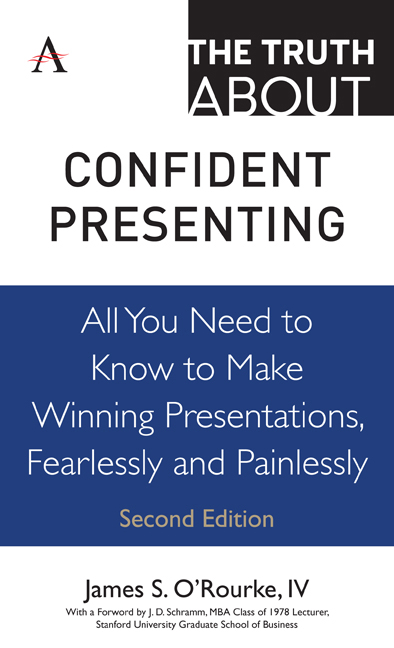 The Truth about Confident Presenting
The Truth about Confident Presenting Book contents
- Frontmatter
- Contents
- Foreword
- Introduction
- Part I Some Initial Truths
- Part II The Truth About Getting Ready to Speak
- Part III The Truth About What Makes People Listen
- Part IV The Truth About Developing Support for Your Presentation
- Part V The Truth About Getting Up to Speak
- Truth 25 Select a delivery approach
- Truth 26 Your introduction forms their first impression
- Truth 27 Begin with a purpose in mind
- Truth 28 Keep your audience interested
- Truth 29 Conclusions are as important as introductions
- Truth 30 Have confidence in your preparation
- Truth 31 Repeat the process as often as possible
- Part VI The Truth About Managing Anxiety
- Part VII The Truth About Nonverbal Communication
- Part VIII The Truth About Visual Aids
- Part IX The Truth About Handling an Audience
- Part X The Truth About What Makes a Presentation Work
- References
- Acknowledgments
- About the Author
Truth 25 - Select a delivery approach
from Part V - The Truth About Getting Up to Speak
- Frontmatter
- Contents
- Foreword
- Introduction
- Part I Some Initial Truths
- Part II The Truth About Getting Ready to Speak
- Part III The Truth About What Makes People Listen
- Part IV The Truth About Developing Support for Your Presentation
- Part V The Truth About Getting Up to Speak
- Truth 25 Select a delivery approach
- Truth 26 Your introduction forms their first impression
- Truth 27 Begin with a purpose in mind
- Truth 28 Keep your audience interested
- Truth 29 Conclusions are as important as introductions
- Truth 30 Have confidence in your preparation
- Truth 31 Repeat the process as often as possible
- Part VI The Truth About Managing Anxiety
- Part VII The Truth About Nonverbal Communication
- Part VIII The Truth About Visual Aids
- Part IX The Truth About Handling an Audience
- Part X The Truth About What Makes a Presentation Work
- References
- Acknowledgments
- About the Author
Summary
Most audience members are completely unaware of the delivery approach a presenter has selected … until they realize that someone is reading to them. For most audiences, that's a horrible feeling. Why? Because most people read aloud in a monotone voice and, unless they were trained as an actor or an announcer, most people can't handle a full script and an audience at the same time. The result: no eye contact, no vocal projection, no sense of personal commitment to the presentation. The reaction: “Why am I here? He or she could have e-mailed this to me.”
So, let's give some thought to methods of delivery. You have basically four options for delivering a presentation, but probably shouldn't depend on more than just one or two of them.
Memorized presentations are delivered verbatim, word-for-word just as the authors wrote them. The problem with memorized speeches is that, unless you are a trained actor, you cannot deliver them with any level of conviction. They sound wooden, contrived and artificial. Worse yet, you may forget where you are and have to start over. Unless you're doing Shakespeare from the stage, forget about memorized talks.
Scripted presentations are far more common among managerial and executive speaking events. The problem with speaking from a script, as I just noted, is that it sounds read. The impression from the audience is almost always negative. Reading a fully scripted speech ensures that you will include each key point and resist the temptation to ad-lib, but without a TelePrompTer to display your script, you lose eye contact with the audience and seem distant or remote to them. You also drop your chin and compress the pitch of your voice. Unless you have no other choice, don't work with a verbatim script. If you must, then rehearse carefully and try looking up frequently, making regular contact with the audience.
Even though I advise against reading from a script, keep in mind 25 that it can serve a number of important functions for you, and perhaps for your employer. First, it is one way of assuring that you'll deliver the speech exactly as written with no additions or deletions.
- Type
- Chapter
- Information
- The Truth about Confident PresentingAll You Need To Know To Make Winning Presentations, Fearlessly And Painlessly, pp. 99 - 102Publisher: Anthem PressPrint publication year: 2019


